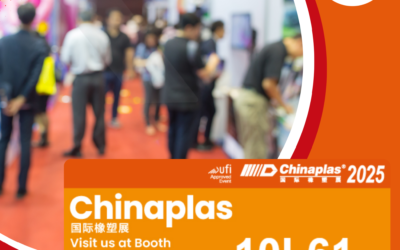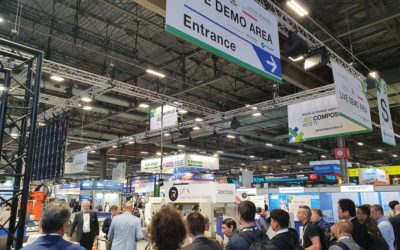Is injecting a recycled polymer more complicated than a virgin polymer? Not necessarily.
Take a look back at the injection tests carried out by Polyvia’s Industrial Performance division, in partnership with Kistler and Roctool, to discover the main points to watch out for and recommendations.
Although plastics recycling has developed considerably over the last ten years, the lack of experience in the processing of recycled plastic materials (RPM) remains a stumbling block for many manufacturers.
Polyvia’s Industrial Performance division is carrying out trials using a range of recycled materials (PET, PP, PC, PC/ABS, PA6, PA66, etc.) to study all injection parameters and support converters in this transition. The tests were carried out on Polyvia’s technical platform, using tooling from the high-temperature GEM demonstrator, Heat & Cool Roctool technology and a Kistler system for measuring in-mold pressure.

Check material moisture content in the pre-processing phase
Some processors of recycled PA encounter problems at the injection stage. The first step in our study was to check the moisture content of the material. A high moisture content can lead to frosting (condensation of water on the mold wall), or even a deterioration in mechanical properties. Conversely, too low a humidity level can lead to irregularities in the filling of the mold cavity.
In our study of a technical recycled plastic from Lehvoss, a recycled PA66 – Luvotech Eco PA66 GF30 BK, we obtained a moisture content of between 0.05% and 0.1%, well below the 0.15% recommended for this type of polymer.
Adjust injection parameters
With regard to the process itself, injection parameters did not vary significantly between virgin and recycled PA66, where only the switching point was adjusted. The holding profile remained of the same order. The cavity pressure curves measured for the two materials are superimposable, signifying identical molding processes.
In the case of materials other than polyamides (PP, PC, ABS, etc.), particular attention needs to be paid to the temperature profile, which will certainly have to be adjusted according to the material’s viscosity.
Improving the surface appearance of rPM parts
Very often, the aesthetics of parts made from recycled materials are not optimal. During tests, the Industrial Performance Division evaluates the impact of heat/cool technology on the surface finish and mechanical performance of parts injected from recycled materials. The Heat & Cool technology developed by Roctool works by induction, integrating networks of inductors into the mold cavity. Before filling, the mold surface is heated over a wide temperature range, from 50°C to 400°C, in a matter of seconds. Cooling is provided by water circuits integrated behind the inductor arrays.
By injecting into a hotter mold, we give the part a glossy appearance. For example, the gloss obtained for a recycled PC/ABS is 88GU with conventional injection molding, whereas with Roctool we obtain 108GU. What’s more, this eliminates weld lines and reduces internal stresses.
The cycle time for a part injected with Roctool technology can be longer, depending on the thermal cycle used, given the need to heat the mold surface to high temperature (in a few seconds), and then cool it down. To minimize this impact and achieve cycle times similar to conventional injection molding, the water flow supplied by the thermoregulators needs to be high, ideally close to 100L/min. With Roctool technology, we achieve improved surface finishes and more reproducible mechanical characteristics than with conventional injection molding.
Anticipate batch variations and stabilize the process
When it comes to recycled material, batch-to-batch variation is a cause for concern. However, this doesn’t necessarily mean complex parameter adjustments.
Identifying reliable sources of recycled material remains paramount, but other solutions exist to simplify process monitoring and control.
In the tests carried out, Kistler’s sensor measurement system is used to observe and refine injection curves in real-time. The positioning of sensors in the mold cavity offers three major advantages, particularly in the case of RPM injection:
- Capture information on the part, at the heart of the process: the microscope effect linked to the presence of sensors amplifies the visualization of filling phenomena and enables more precise curves to be obtained for better detection and anticipation of material variations.
- Impression pressure control optimizes filling and provides greater stability to homogenize parts when changing from a batch of material A to a batch of material B, even in the event of viscosity variations.
- Time-saving: tooling instrumentation provides reference pressure curves for more efficient set-up.
Parameter adjustments are simplified from cycle to cycle, avoiding production rejects.
Demonstrations
If a picture is worth a thousand words, a demonstration is certainly worth a hundred times more. To help you better understand the impact of recycled material on the injection process and the technologies that facilitate its transformation, demonstrations are available.
These can be organized on Polyvia Formation’s technical platforms in Lyon (equipped with Roctool’s Heat & Cool technology and the Kistler measuring system) or in Alençon (equipped with the Kistler measuring system).
https://www.polyvia.fr/fr/innovation-materiaux/optimiser-linjection-de-matieres-plastiques-recyclees
Contact Polyvia’s Industrial Performance Division to find out more.
performance-industrielle@polyvia.fr
+33 9 71 00 99 52


